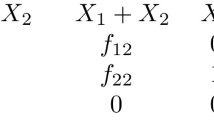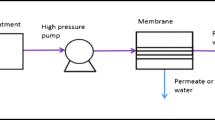Abstract
Transcellular transport in epithelial cells plays an important role in providing such physiological functions as excretion of cytotoxic substances or reabsorption of metabolites useful for the body life activity. These functions have been shown to be performed by the mechanisms—symport, antiport, ion pumps, and channels—that often function cooperatively. Models for kinetic peculiarities of the substrate transport with the aid of the above mechanisms are widely described in the literature. Much less attention is paid to modeling of cooperative activity of transporters that have different transport mechanisms. In this work we propose a mathematical model for flux coupling of three transporters—the ion pump, symporter, and antiporter as well as of two substrates, one of which (A) can be transported simultaneously by the symport and antiport mechanisms, while the other (B)—only by the latter mechanism. Analysis of the model has shown that for the pair of substrates (A and B) the flux coupling becomes possible if the following conditions are met: (1) the substrate A flux into the internal cell volume using the symport mechanism is to exceed its antiporter-realized flux in the opposite direction; (2) probability of reorientation from one side of membrane to the other side for the antiporter loaded with the substrate is to be essentially higher than that for empty transporter. The proposed model can be used for comparing efficiency both of excretion and of reabsorption of cell metabolites in representatives of different taxa.
Similar content being viewed by others
References
Burckhardt, B.C. and Burckhardt, G., Transport of Organic Anions across the Basolateral Membrane of Proximal Tubule Cells, Rev. Physiol. Biochem. Pharmacol., 2003, vol. 146, pp. 95–158.
Orlov, Yu.N., Mechanisms of Secretion of Toxic Organic Anions in Mammalian Kidneys, Membr. Cell Biol., 1997, vol. 11, pp. 417–429.
Mc Givan, J.D. and Pastor-Anlada, M., Regulatory and Molecular Aspects of Mammalian Amino Acid Transport, Biochem. J., 1994, vol. 299, pp. 321–334.
Burckhardt, G., Bahn, A., and Wolff, N.A., Molecular Physiology of Renal p-Aminohippurate Secretion, News Physiol. Sci., 2001, vol. 16, pp. 114–118.
Ullrich, K.J., Rumrich, G., and Klüss, S., Biodirectinal Active Transport of Thiosulfate in the Proximal Convolution of the Rat Kidney, Pflugers Arch., 1980, vol. 387, pp. 127–132.
Ullrich, K.J. and Papavassilious, F., Contraluminal Transport of Small Aliphatic Carboxylates in the Proximal Tubule of the Rat Kidney in situ, Pflugers Arch., 1986, vol. 407, pp. 488–492.
Stein, W.D. and Lieb, W.E., Transport and Diffusion across Cell Membranes, Orlando: Acad., 1986.
Abramson, J., Iwata, S., and Kaback, H.K., Lactose Permease as a Paradigm for Membrane Transport Proteins (Review), Mol. Membr. Biol., 2004, vol. 21, pp. 227–236.
Frohlich, O. and Gunn, R.C., Erythrocyte Anion Transport: the Kinetics of Single-Site Obligatory Exchange System, Biochim. Biophys. Acta, 1986, vol. 864, pp. 169–194.
Murer, H., Biber, J., Gmaj, P., and Stiger, B., Cellular Mechanisms in Epithelial Transport: Advantages and Disadvantages of Studies with Vesicles, Mol. Physiol., 1984, vol. 6, pp. 55–68.
Aronson, P.S., The Renal Proximal Tubule: A Model for Diversity of Anion Exchangers and Stilbene-Sensitive Anion Transports, Annu. Rev. Physiol., 1989, vol. 51, pp. 419–441.
Cuggino, W.B. and Cuggino, E.S., Renal Anion Transport, Kidney Internat., 1989, vol. 36, pp. 385–391.
Massd, T.S., Ach, J.P., and Aronson, P.S., pH-Coupled Lactate Transport in Renal Microvillus Membrane Vesicles, Kidney Internat., 1987, vol. 31, p. 412.
Pritchard, J.B., Rat Renal Cortical Slices Demonstrate p-Aminohippurate/Glutarate Exchange and Sodium/Glutarate Coupled p-Aminohippurate Transport, Amer. J. Physiol., 1988, vol. 255, pp. F597–F604.
Rebane, E.N., Orlov, Yu. N., Kazbekov, E.N., Lyubimov, Ya., and Bulat, M.N., Mechanism of Coupling of Transport of Organic Anions with Na+-Dicarboxylate Symport in Basolateral Membrane Vesicles, Biol. Membrany, 1998, vol. 15, no. 1, pp. 43–47.
Schmitt, C. and Burckhardt, G., p-Aminohippurate/Ketoglutarate in Bovine Renal Brush-Border and Basolateral Membrane Vesicles, Pflugers Arch., 1993, vol. 423, pp. 280–290.
Author information
Authors and Affiliations
Corresponding author
Additional information
Original Russian Text © E. N. Rebane, Yu. N. Orlov, 2008, published in Zhurnal Evolyutsionnoi Biokhimii i Fiziologii, 2008, Vol. 44, No. 1, pp. 32–38.
Rights and permissions
About this article
Cite this article
Rebane, E.N., Orlov, Y.N. Mathematical model of cooperative work of ion pump, symport and antiport in epithelial cells. J Evol Biochem Phys 44, 36–43 (2008). https://doi.org/10.1134/S0022093008010052
Received:
Published:
Issue Date:
DOI: https://doi.org/10.1134/S0022093008010052




